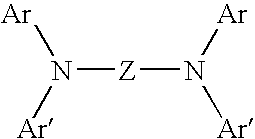Halogenated bisdiarylaminopolycylic aromatic compounds and polymers thereof
a technology of bisdiarylaminopolycyclic aromatic compounds and polymers, which is applied in the direction of discharge tube/lamp details, solid-state devices, organic semiconductor devices, etc., can solve the problems of sluggish electron removal, hole injection, and homopolymer not particularly suitable for electroluminescent devices
- Summary
- Abstract
- Description
- Claims
- Application Information
AI Technical Summary
Problems solved by technology
Method used
Image
Examples
example 1
Preparation of 4,7-bis(N-(4-bromophenyl)-N-p-tolylamino)-2,1,3-benzothiadiazole
A. Preparation of 4,7-bis(N-phenyl-N-p-tolylamino)-2,1,3-benzothiadiazole
[0029] Palladium acetate (0.18 g, 0.8 mmol) and tri-o-tolylphosphine (0.49 g, 1.6 mmol) were dissolved in toluene (25 mL). The solution was stirred at room temperature for 15 minutes, whereupon 4,7-dibromo-2,1,3-benzothiadiazole (2.94 g, 10 mmol), 4-methyldiphenylamine (5.0 g, 27.3 mmol) and potassium t-butoxide (3.84 g, 40 mmol) were added. The mixture was refluxed under nitrogen overnight, then cooled to room temperature. Water (˜20 mL) was slowly added to the mixture and the organic portion was extracted with several portions of toluene. The combined organic extracts were washed with brine, then dried over magnesium sulfate. Solvent was removed in vacuo, and the residue was redissolved in a 1:1 v / v mixture of toluene and hexane and passed through a silica gel column. Recrystallization from ethanol gave the title compound as a de...
example 2
Preparation of 2,7-Bis(4-methyl-4′-bromo-diphenylamino)-9,9-dioctylfluorene Monomer
A. Preparation of 2,7-Bis(4-methyldiphenylamino)-9,9-dioctyfluorene
[0031] Pd(II) acetate (0.90 g, 4 mmol) and tri-o-tolylphosphine (2.435 g, 8 mmol) were stirred at room temperature in anhydrous toluene (125 mL) for 15 minutes, whereupon 2,7-dibromo-9,9-dioctylfluorene (27.4 g, 50 mmol), 4-methyldiphenylamine (22.91 g, 125 mmol), and sodium-t-butoxide (19.75 g) were added. The mixture was heated to reflux under nitrogen overnight, then cooled to room temperature, then a first portion of water (˜100 mL) was added slowly followed by further dilution with water (˜200 mL). The aqueous phase was then separated from the organic phase and the solvent was removed in vacuo. The residue was redissolved in toluene (˜100 mL) and the solution was passed through an alumina column. The product was concentrated in vacuo and precipitated from methanol. The crude product was recrystallized from p-xylene as white crys...
example 3
Preparation of 1,4-Bis(4-methyl-4′-bromo-diphenylamino)naphthalene Monomer
A. Preparation of 1,4-Bis(4-methyldiphenylamino)naphthalene
[0033] Pd(II) acetate (78 mg, 0.35 mmol) and tri-o-tolylphosphine (0.21 g, 0.7 mmol) were stirred at room temperature in anhydrous toluene (50 mL) for 15 minutes, whereupon 1,4-dibromonaphthalene (5.00 g, 17.48 mmol), 4-methyldiphenylamine (6.44 g, 35.13 mmol), and sodium-t-butoxide (4.20 g, 43.7) were added. The mixture was heated to reflux under nitrogen overnight, then cooled to room temperature, whereupon HCl (˜20 mL) was added slowly. The mixture was filtered and the filtrate was passed through a basic alumina column. The toluene was removed to yield an orange solid. The solid was recrystallized from hexanes to yield a tan solid 5.3 g (62 percent).
B. Preparation of 1,4-Bis(4-methyl-4′-bromo-diphenylamino)naphthalene
[0034] A solution of N-bromosuccinimide (2.90 g, 16.3 mmol) dissolved in DMF (˜20 mL) was added at −10° C. with stirring to a solu...
PUM
 Login to View More
Login to View More Abstract
Description
Claims
Application Information
 Login to View More
Login to View More - R&D
- Intellectual Property
- Life Sciences
- Materials
- Tech Scout
- Unparalleled Data Quality
- Higher Quality Content
- 60% Fewer Hallucinations
Browse by: Latest US Patents, China's latest patents, Technical Efficacy Thesaurus, Application Domain, Technology Topic, Popular Technical Reports.
© 2025 PatSnap. All rights reserved.Legal|Privacy policy|Modern Slavery Act Transparency Statement|Sitemap|About US| Contact US: help@patsnap.com



